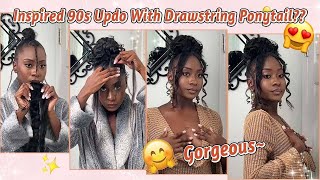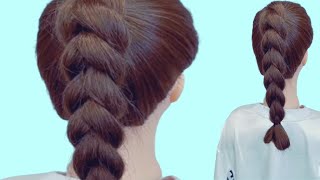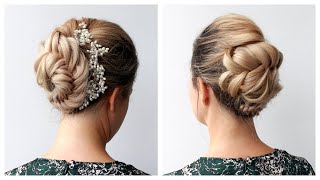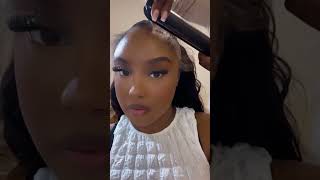The Basics Of Drawing Hair, Part 3: Hairstyles, Updos & Accessories
- Posted on 17 July, 2022
- Updos
- By Anonymous
Hi friends!
In this week's video, we expand more on the basic of drawing hair. We'll go over some key points to consider when drawing hairstyles and hair accessories, as well as certain things you want to avoid.
This video is part of a series on hair basics - check out the rest here:
Part 1: The Basic Basics https://youtu.be/ikyVGnAORsE
Part 2: Textures, Volume & Shape https://youtu.be/qZIb1Ypfmjo
Thanks for watching!
Other Infotainment:
Done on my iPad using Procreate and my Apple pencil, as per usual with my digital pieces.
The music was composed by the talented Christopher Songco exclusively for my channel! Check him out at his website: https://www.chrissong.co/
More Art Stuff Here:
Instagram: https://www.instagram.com/winklebeebee...
Website: https://winklebeebee.com
All drawings done in my videos are ©Kirsten Winkelbauer (that's me!) - please do not copy or reproduce said work for public or commercial use. This video is for demonstration purposes only.
Hey everyone today we're going to do part three of the basics of drawing hair, hairstyles, updos and accessories. So first things. First, let's talk about hair Direction and points of tension. I'Ve already talked in previous videos about hair Direction and how hair moves, and this video is really just an extension of that. Drawing different hairstyles is really just about being deliberate about the direction that you're pulling the hair and the way that it's held in place. In order to create the style that you're going for the key thing to keep in mind is thinking about where the hair comes from when it grows out of your scalp and where it's going to something like a ponytail shouldn't. Look like it was just taped to the back of someone's head. It has to look like the hair was pulled back to reach whatever spot. You want the ponytail to be coming out of and then held in place there. This means that the hair direction is going to change, depending on where your hairstyle is settled. There'S a huge variety of ways to draw hairstyles, but a rule of thumb to keep in mind for most things like ponytails and buns and updos. Is that hair towards the front of the head and along the hairline will be pulled up and back whereas hair at the back of the head and at the base of the neck will be pulled up? This will change depending on certain hairstyles, but for a lot of really basic hairstyles. This principle applies whether it's a bun, a ponytail space buns. Anything like that, a little trick you can try is to draw a horizontal line across wherever your hair tie or hair accessory is and any hair. That'S above that line will get pulled down and any hair below that line will get pulled up. Also, keep in mind that tying hair up affects its volume. Hair will look a lot smaller at that point of tension where you tie it up because you're compressing all the hair together, but once it's released from that point of tension, its volume should go back to normal, alright. So now, let's go over some things to consider. When you're drawing different hairstyles starting with ponytails the length thickness and texture of the hair is going to affect how the ponytail looks short, hair is going to stick out more, whereas long hair is going to be pulled down in the same vein, thin hair is going To look even thinner at the point where it's tied because it's compressed to a smaller space, whereas the care is going to have less of that effect and might even be curly or textured enough to obscure the hair tie altogether. You also want to think about the location of the ponytail and how tight it is. A ponytail, that's very high and tight tends to have more pieces that stick out and it tends to be forced upwards and curved before it falls back down, whereas a loose and low ponytail doesn't really have that. It'S also important to remember that ponytails are going to have different links throughout, especially if a person has something like layers. This is because your hair grows out of all different parts of your scalp. Not every piece of hair is the exact same length and when you pull it in a specific Direction, not every piece of hair is going to be tied at the exact same spot. When it reaches that hair tie, you really have to consider the distance that that hair has to move along the shape of the head before it's tied and how much hair is left to stick out of that hair tie afterwards in order to determine the different size Pieces that are going to be coming out of that ponytail. These examples show a single ponytail, but the exact same principles apply to anything that has multiple ponytails like a pigtail Style in that sort of situation. You'Re just going to have more than one point that the hair is drawn to, so you have to think about sectioning off the hair and then having each section pulled to a specific spot. Now, let's talk about buns, so buns and ponytails are basically the same thing. The only difference is instead of the hair, just coming out of the hair tie and falling straight down, it's either rolled or it's wrapped or in some way styled in a way that compacts it into a relatively round shape. Again, this is going to be affected by the length thickness and texture of the hair. Those things will really change the shape and the size it'll affect how much hair sticks out of it, and it also is going to depend on what kind of bun you're trying to do something really irregular or messy, is going to have a lot more unpredictable pieces. Whereas something like a donut bun or like a chignon shouldn't, you pronounce are going to look much more sleek and styled also don't forget to always think about where the hair is coming from and where it's going and that way the hair will make a lot more Sense when you're drawing it one, wavy or curly hair is styled a lot of times. Those coils are stretched out and flattened, so you won't get as much of that defined curl in it. But, depending on how it's styled, you will oftentimes still retain some of that. Waviness and some of that texture, of course, it's possible to make curlier wavy hair, look very, very sleek and flat, depending on how it's styled or what kind of products you use in it. So it really just depends on what kind of look you're going for in your drawing, but regardless of hair texture, you really want to focus on the direction of the hair, because that's what's going to make the hairstyle make sense and make it easier to draw. There. Isn'T really a right or wrong way to style or draw a bun, because they can change so much depending on a person's hair or things like bobby pins or hair products? So you can really make them as perfect or as messy as you want them to be. The same principles still apply, regardless of if it's a single bun or something like space, buns or bantu knots that utilize more than one bun. The same goes for different textures of hair. It doesn't matter if someone has very thin fine, hair or very thick dreadlocks. The motion of the hair in the direction is going to be the same. You just have to take into account the differences in thickness and texture. Now, let's touch on braids and twists, starting with a simple three strand braid, I'm only doing this kind of braid right now, because it is one of the simpler ones to understand, and I don't want to get too overly complicated with it. But once you understand how braids work you can then start to do more complicated, braids and more complicated hairstyles, so this style is created by three sections of hair overlapping each other. In a repetitive pattern, this can get a little complicated and hard to keep track of, but fortunately you don't have to draw every single section of hair for it to look convincing. So here I'm breaking down the way that I draw braids just by creating this kind of repetitive pattern and then fleshing it out and filling it out a little bit. It still looks convincing, but it doesn't involve me having to actually follow the paths of each of those three sections of hair. The more important thing to focus on is making sure those sections of hair look like they're overlapping each other or going over and under each other, also just to clarify twists, are a little different than braids and that it's two sections of hair that are wrapped around Each other usually, which is a little less complicated than braids and can be a little easier to draw. So that's just something to keep in mind just like, with all of the other hairstyles that we've gone over so far, braids come in a ton of different varieties and there isn't one specific way to draw them. I'M giving a few examples here, but that's really just scratching the surface on what you can do with braids. So once you're comfortable with a general breakdown of them, spend some time researching it and really looking at the different styles that there are in order to see what you can really do with these drawings, once you're comfortable with them. However, there are a couple things I like to keep in mind, just as a general rule of thumb. The first one is that braids generally get smaller towards the bottom, because our hair tends to be thinner at the bottom and so you'll see that change in volume. And the second is that the look of the braid will change a lot depending on how tightly it's pulled. Hair. That'S braided, really tightly will generally be smaller than hair. That'S braided Loosely simply because you're taking that hair and compressing it more tightly than with loose braids. So just keep that in mind for the overall look of the drawing that you're doing foreign. I didn't do more demos here, my tendonitis flared up and my hand really started to hurt. The last thing on the subject of braids I want to talk about is how the look of a braid will change, depending on how it's tied. Consider if it's tied just at the bottom of the hair, if it's tied in multiple places like at the top and the bottom of the section of braid or how far along the hair, is actually braided. So you might have a lot of hair sticking out after the hair tie, or maybe just a really small amount. All of these factors can change the look of the hair, but there isn't a right or wrong way to do it. It'S really just about your personal preference, so unless it's styled or uses a lot of product, most people's hair isn't perfectly sleek and smooth most of the time you're going to have loose strands of hair or hair that isn't perfectly in place. And it's also really common to see strands of hair sticking out along the hairline or at the base of the neck, especially if there's any kind of breakage or damage or just in areas of the head. Where hair tends to be a little bit more fragile and those are all things you want to take into consideration when you're drawing hairstyles, adding in little variations like. That is a great way to add visual interest and appeal to your drawing. Sometimes, if you draw a hair, that's too perfectly styled, it tends to be a little bit boring or a little bit stagnant, so adding in those visually interesting pieces will make the drawing more interesting to look at and it'll give your whole drawing more character. Of course, this can change, depending on the type of character that you're drawing, because maybe you're drawing someone who is very, very severe or very Stern, in which case a perfect bun might work well for that character, so just base it on the character that you're creating You can't really talk about all these kinds of hairstyles, without also talking about the accessories that you would use to make those hairstyles possible accessories not only affect how the hair behaves, but they can also change the look of a character. These can be as simple as an elastic or rubber band, or you can try something, that's more visible or more interesting, like a really big scrunchie or a ribbon or even a length of rope or leather. There are also things like Bobble hair ties, barrettes Clips things like that, which are not only functional but can add character to a hairstyle utilizing different hair accessories like this is a great way to show off the personality of the character that you're drawing, because it's a Reflection of their personal style and how they like to present themselves when you're, using clips and barrettes remember that they have the same principles as any other updos you're taking hair and you're, pulling it in a specific Direction and then you're holding it in place. Just like. With a ponytail you'll notice that you're pulling that hair to a specific spot and in this case, you're holding it in place with a clip or a Barrette, but once that hair leaves that point of tension, gravity takes hold and the hair will fall downwards again. The last thing we're going to touch on in this video is shaved hair. This is one of many reasons why it's so important to understand the anatomy and the shape of the head underneath the hair, if you're drawing somebody with a shaved head or who is bald, there is no hair there to cover any potential imperfections or any areas that You don't fully understand and if you don't have a full grasp of that Anatomy, it's very very obvious to the viewer. So you want to make sure you know: what's underneath that hair, so you can draw it accurately, there's also the added challenge of creating visual interest. As well as a sense of form and depth when you're not working with hair, because you really have to rely on light and shadows to create the shape of the head as well as create something interesting to look at, it does start to get a little bit Easier when you're working with hair, that's partially grown out and is a little bit fuzzy or a little bit stubbly, because you can start to rely on color to indicate that there's hair there. This will differ depending on your own style of drawing, but you can create the effect of short stubbly hair by laying in an overall hair, color working on your light and shadows and then going in after and detailing with a hair brush or a really fine brush To create those short Strokes that indicate the hair, you don't want to overdo it and draw too many of them, because that'll make it look flat and unrealistic, but just enough to indicate the hair growth, you can also draw a few strands of hair poking up from The scalp to really add both the visual interest and to indicate that there is hair growing there when you're growing out hair. That'S been shaved. Generally speaking, it'll stick straight out of the scalp until it's long enough to start weighing itself down and bend over itself at which point it'll start to hang downward. You can also utilize partially shaved areas, depending on the look that you're going for when you're combining a shaved section with a section of hair, that's grown out. You just have to think again about where the hair is originating from. In this example, there's a really clear delineation between the shaved area and the hair that's growing out and where the hair is growing out right along that shaped part, essentially acts like a hair part. The hair is going to grow up from there and then curve over the side of the head, depending on how that shaved part is done, is going to change the delineation between the shaved area and the grown out area. If it's very neatly and precisely shaved and has been done very recently - you'll have that really strong delineation. But if the hair is being grown out - and it's already starting to stick up a little bit, you'll start to see some of that growth and the delineation might not be so obvious. Hairstyles are a really great way to show the personality of a character that you're drawing. So you always want to think about what kind of look they're giving off and if that reflects the kind of character that they are. You could be drawing somebody who likes to be a little adventurous or alternative, or somebody who likes a very traditional hairstyle or maybe you're, drawing someone who's really really into Avatar, and before I wrap up this video, there are just a couple other points I wanted to Add in that, I think, are really important to remember when you're drawing hair, because, depending on the scenario that you're drawing your character in these could be applicable, the first thing to keep in mind is hair, looks really different when it's wet or when it's dirty hair. That'S wet or dirty is compressed and the hair strands are brought closer together, so it looks more Compact and tends to have less volume. You also want to remember that when your hair is wet, especially if it's soaking wet the weight of the water will drag the hair down and it makes the hair look longer when it's wet than when it's fully dry. The next thing might be important, depending on the kind of character you're trying to create, but keep in mind that treated hair will look a lot different than hair, that's natural or undamaged, and by treated I mean hair, that's overly bleached or processed when you bleach or Process, your hair, you tend to dry it out and it can oftentimes get breakage which can lead to your hair, looking frizzy or damaged. This might actually be something you want to incorporate into a character so think about how that would change the effect of the hair and the overall look of the hair and see if it's something that works for your character. And the last thing, I think, is the most important, which is there aren't really a lot of limitations when it comes to drawing hair. Hair products and hair tools are basically magic and you can do just about anything with hair and it's really only dependent on how creative you are with your drawing as long as your sense of hair Direction and hair growth, as well as points of tension and points Of Origins make sense, that's pretty much all you need to make a hairstyle look convincing, regardless of how crazy or how traditional the rest of the hairstyle is all right. That'S it for today's video. Thank you guys so much for watching. I hope that was helpful to some of you. If there's anything, I missed or anything you'd like me to touch on in a future video go ahead, and let me know down in the comments - and I will do my best to make it happen and until my next video, I hope you guys have a great Day, bye,





Comments
Froggy: Thank you so much for this episode, I’ve been having lots of trouble with drawing hair ❤️
StrawberryKake_: This is wonderful and really really helped me feel like I could make my hair look so much better in drawings. It wasn't bad before but it always felt flat! This series helped me create volume filled pigtails and straight bangs on my character without making her look like a paper doll :) So far I've sketched the best hair I've ever done after watching all 3. This is the best series I've ever watched for art tips, I seriously can't wait to put these into use with all my drawings.
Ryan: p♥r♥o♥m♥o♥s♥m